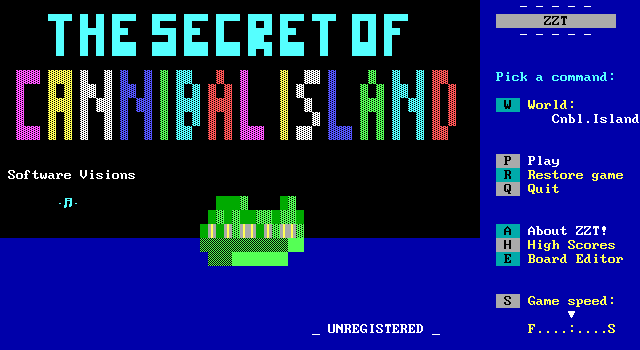
Today it's a return to the greats, with the so far overlooked Alexis Janson getting one of her games covered for the first time since BugTown. As far as ZZTers go, it's really difficult to argue for anyone other than Janson as being the single individual who made the most important contributions to ZZT (barring Sweeney for you know, making it). The big one, is of course the creation of Super Tool Kit, allowing ZZTers to vastly expand the engine's limited graphical capabilities and resulting in the creation of some rather stunning designs over the years that would just be impossible otherwise.
But while STK changed the scene from a technical standpoint, she also was a major influence on how ZZT games were made, pioneering the lengthy and overly flashy title screen cutscene as well as creating games known for their impressive levels of interactivity with Mission: Enigma and Code Red respectively.
But for now, we're moving on to a not quite as influential release, with her 1993 release The Secret of Cannibal Island, a classic styled ZZT adventure that shows considerable growth and gameplay development from the previously seen BugTown, while not yet reaching the heights of her later games.
(This a good time to bring up that Alexis Janson issued minor revisions to her games, usually to just add the "Software Visions" label. I'm playing the 1995 release, but the documentation indicates the date as 1993).
If BugTown was just a strange take on Town of ZZT, then Cannibal Island is Best of ZZT with some more of Janson's own originality and creative vision being apparent. It's no rehash, but there are definitely a few places where it's easy to mix the two games up in your mind. This seems to be a good midpoint, between something new and innovative and something more in the vein of the official worlds published by Epic.

Aside from Best of ZZT, the game's Monkey Island influence is also pretty apparent. The game is divided into four (technically) parts, with each one having one of these chapter screens, again, just like The Secret of Monkey Island. Janson even plays a rendition of Monkey Island's chapter theme. It's not bad at all!
And again, here's Janson's theme and some variants of the source material:
Monkey Island - PC Speaker
Monkey Island - AdLib

Stepping away from Monkey Island and back towards Best of ZZT, the game begins with the player in the center of a forested board filled with various ZZT enemies, and a small rectangular village to enter. It's really obvious if you've played both games.
Of course, there's no ammo, and all the doors are locked, so the only options the player has are to enter the village, or enter a passage labeled "INFORMATION".

Alexis Janson includes a full board dedicated to explaining what the unique elements of the game are and how they behave. Offhand, I can think of Fred!: Episode 2 which does the same thing, though it does so from a main menu rather than something that can be accessed in gameplay.
Cons: The descriptions are all in scrolls, so you can only reference these things once. A lot of them also only appear on just one board and it's easy to forget the specifics by that point. It might have been more practical to explain it on the boards with these elements.
Pros: This board rules. I adore it. Playing this game as a kid it made me want to have these big lists of neat new things in my games. It gives this game a lot of flavor and does a ton to entice the player by letting them know that they're going to be fighting Blockheads and trying not to be harmed by Splitters. If you don't see this board and immediately want to read every scroll I don't know what to tell you.
Food will restore 5 of your health
points.
Magic Hearts will restore 10 of your
health points.
Potions have many effects, good and
bad, depending upon the color of the
bottle, as follows-
Each Bag of Gold is worth 250 bonus
points. They do not give you any Gems.
A Large Ammo is actually five regular
Ammos in one. That is, it's worth 25
Ammo units.
Boiling Lava blocks your path, like
water, although you cannot shoot over it.
Splitters, when shot upon their tip,
will split that shot in two, and the two
new projectiles will continue in opposite
directions, perpendicular to the original
direction.
Splitters are usually seen with
Rerouters and Spinning Guns.
Replicators are similar to
Duplicators, except a Duplicator copies
an image every so often, but a Replicator
only copys when you or an enemy shoots
it from any angle.
Loose Rocks are a tougher version of
breakable walls. The only way to destroy
them is for Blockheads (see enemies) to
run into them.
Toll Booths cost you a specific
number of gems to go through. There are
two flavors- Yellow and Blue.
Yellow Toll Booths, symbolized by a
`1`, cost 10 gems to pass.
Blue Toll Booths, symbolized by a
`5`, cost 50 gems to pass.
The Blockhead will run away at all
costs. Don't chase it too closely, for if
it attacks you, you lose 25 health points!
If the Blockhead runs into Loose Rock
it will destroy it and itself. The only
other way of killing them is with a bomb.
The Ice Dragon has something you
might need...
Retrieve this item for a reward...
Most trees have signs nailded to
them, to help you decide where to go.
These are special keys. Unlike
regular keys, you can hold many of these
at once. They will not show up on your
inventory, though.
These are opened with Ruby Keys.
Each Ruby Key opens one and only one Ruby
Door
This is a special key. There is only
one in the entire game.
These can only be opened with the
Gold Key, but one key can open many doors.
• • • • • • • • •
For your sake though, I'm going to combine all that text into just one scroll here. It starts with your basic ZZT objects, hearts/food for healing. (I think a lot of games began using the ƒ symbol for "food" after this.)
Then you get the potions which have some strange effects. Just remember not to pick up any red potions and you'll be fine, as the others are all beneficial.
The terrain is where things get neat. Lava, which is just a wall, but styled after ZZT water (and not Super ZZT which has its own lava element). Splitters, which can quickly turn a situation deadly as bullets begin to multiply. Replicators which are a very fancy way of saying "one board lets you make boulders by shooting these purple arrows".
The toll booths are also interesting because of how wild this game's economy is. Though there isn't any shop to buy from, there are hundreds of gems to collect, and getting as many as possible is essential to getting supplies since they're frequently behind toll booths.
It's a lot to take in, and we'll deal with things as they come up, but getting all this at the start of the game really does wonders to making Cannibal Island feel like a very complex ZZT world.
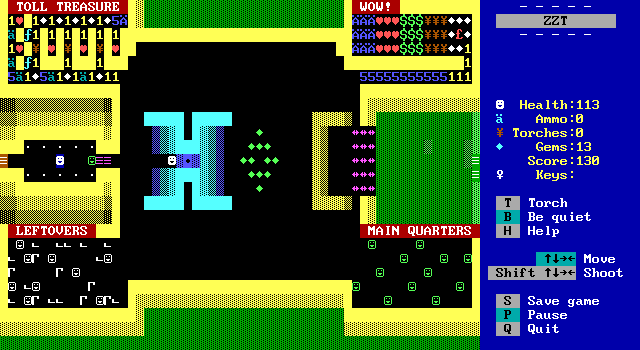
The cannibal village is the aforementioned source of supplies. You can see a ton of gems would be needed to get everything, and by the end of the game I nearly had. For now though, the player can't enter the main village as it's blocked by the cannibal leader.
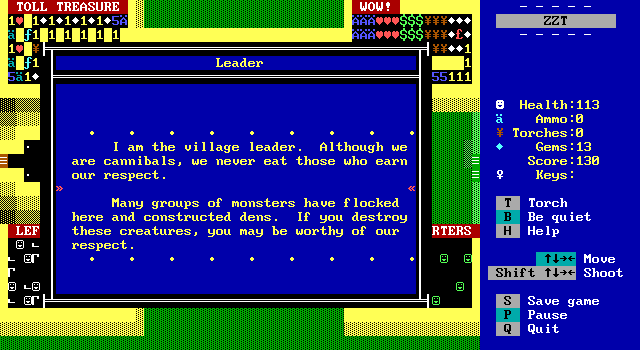
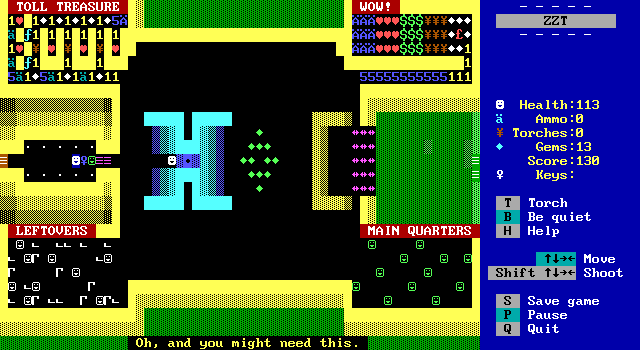
The unnamed protagonist receives their first quest, to clear out some monsters for the cannibals and earn their respect. Until that respect is earned, there's no aid to be found, the player doesn't even get any ammo to get the job done, but a key to the caves, full of their own dangers with items to collect there instead.
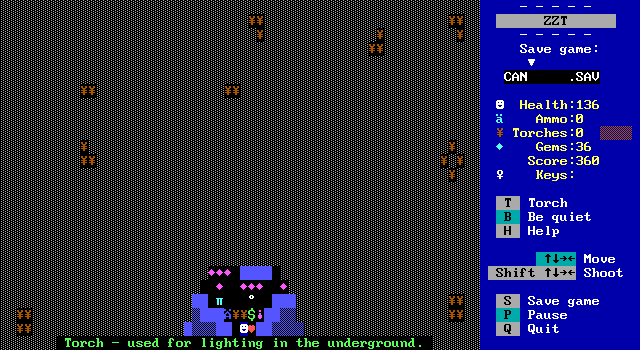
Fortunately, Janson isn't too cruel. The cave's mouth immediately gives the player some ammo, torches, health, and a potion to turn centipedes into gems.
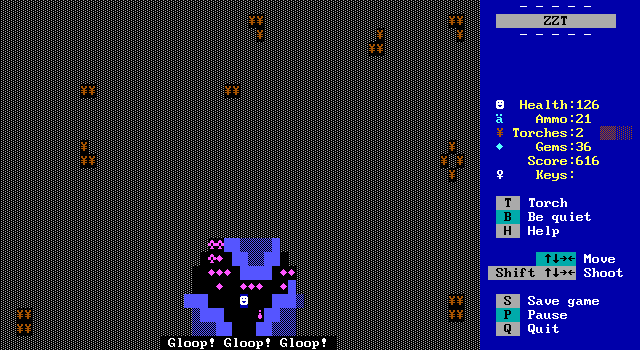
It takes a moment to actually consume though.
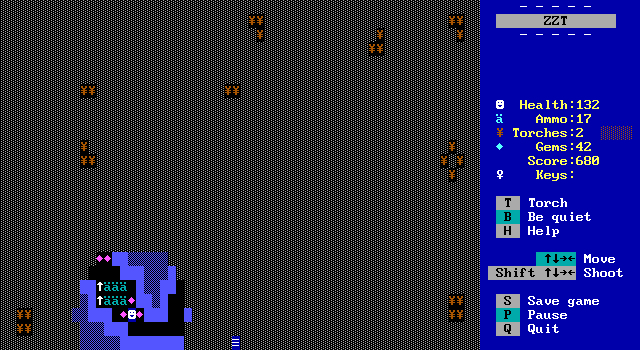
The cave is extremely dangerous, and littered with a lot of items to pick up. There's a decent amount of healing from items and gems, but the spinning guns fire so fast that it's very easy to lose significant health trying to cross.

There's also no indication that there's a reason to explore the whole thing. I stocked up on what I felt was an adequate amount of ammo and headed right back out, knowing more was there if I needed it.
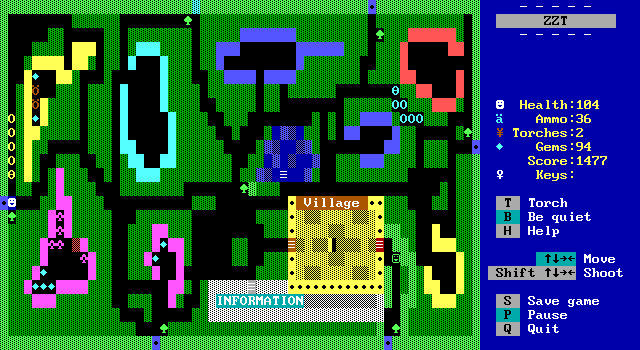
Getting to work on completing the quest, it's worth noticing that all the monsters are contained by breakable walls and forests which lets the player be methodical and take out each nest of enemies one by one.
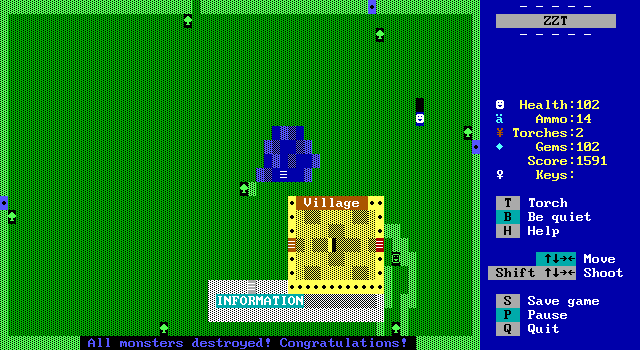
When they are all defeated, the nests vanish and everything is replaced with forest. It makes the board look very empty compared to the fun look of the original version of the board.
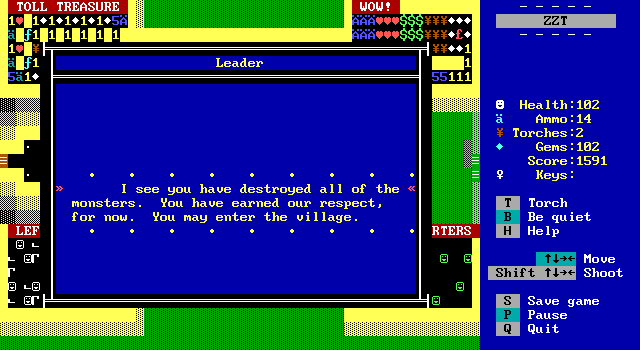
With the quest completed, the protagonist can enter the village, but it's not all that exciting for a village full of cannibals.
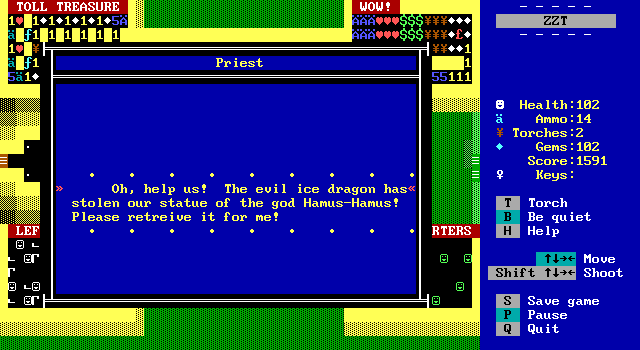
In the center of the village is the next quest, getting the statue back from the ice dragon.

There's of course the "leftovers" corner which is great. Just a whole bunch of bones, but worth investigating to do some looting of corpses.
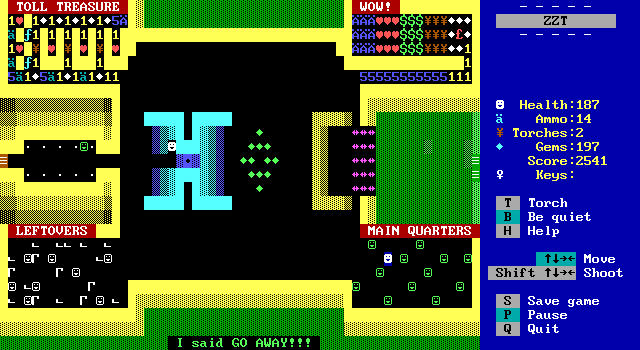
The cannibals themselves are an unfriendly bunch. While the player isn't in any danger of becoming a meal directly, talking to them more than once results in them shooting at the player once, so they can be deadly.
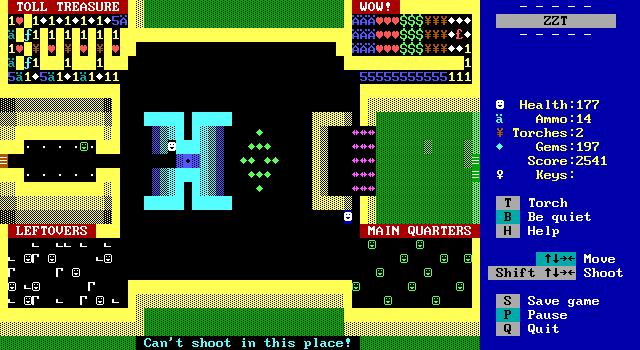
Other than that, are the two treasure rooms. The one on the left is a lot cheaper, but the rewards don't really seem to be worth it. The one on the right meanwhile, has a steep price of 600 gems to get anything out of it, but it means considerable rewards including a ruby key which is required to complete the game. I decided to try and avoid opening the left treasure room at all until I had opened up the one on the right.
Even playing a 1993 game by Janson, I was confident that soft-locking wouldn't be an issue, but I've been burned by so many games that I'm paranoid no matter whose name is attached to a game.
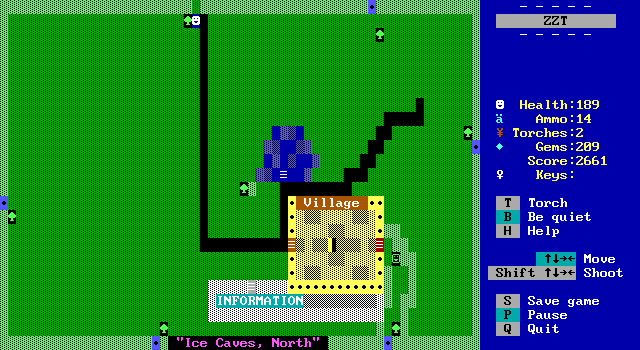
Even with the "respect" of the cannibals, all the doors are still locked, save for one path that opens up to the Ice Caves where the dragon and statue can be found.
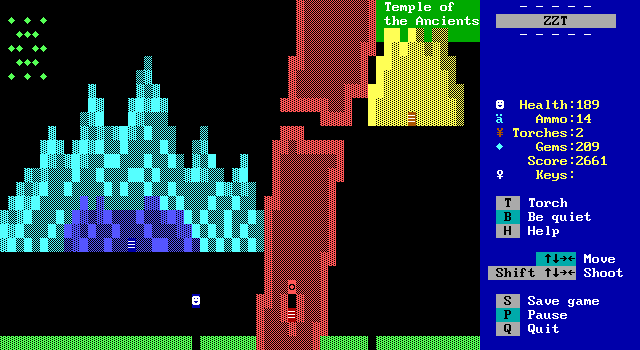
A large canyon cleaves the board in half, cutting the Ice Caves off from the "Temple of the Ancients". I guess that's a fairly generic name for a place, but if it's meant to be a reference, it's difficult to find out what since everybody these days associates that place with Final Fantasy 7.
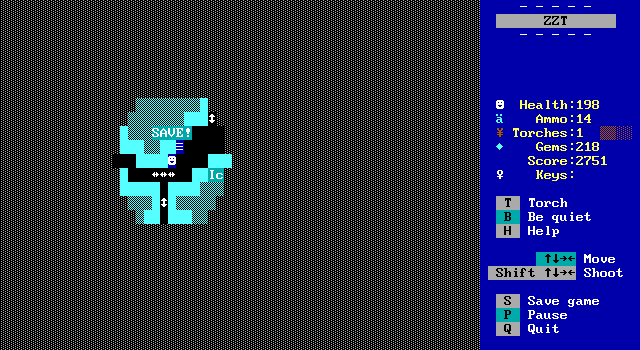
Again the player has to deal with a dark room, but this time there's a kind of frustrating danger of being able to push sliders around in such a way that the board can no longer be completed. Sometimes, the radius of torch-light is enough to reveal this to be the case, but other times it's not as clear.
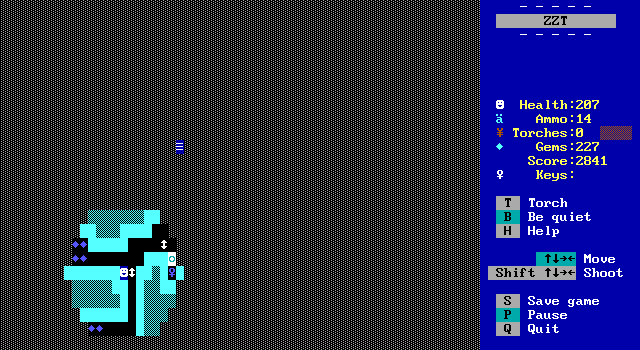
Like here for instance, where I've pushed the slider down to access this left path. It looks like there's going to be another path to push the slider up from below, but in reality it's a one way passage, so I was already wasting my time. Thankfully I took the advice and saved a new file before doing anything in here.
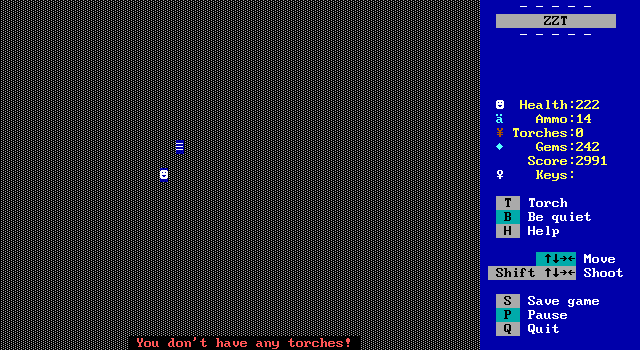
The thing with the caves being a not very friendly place to get supplies from, is that it meant I didn't exactly grab a lot of torches. I'd have to go back for more.
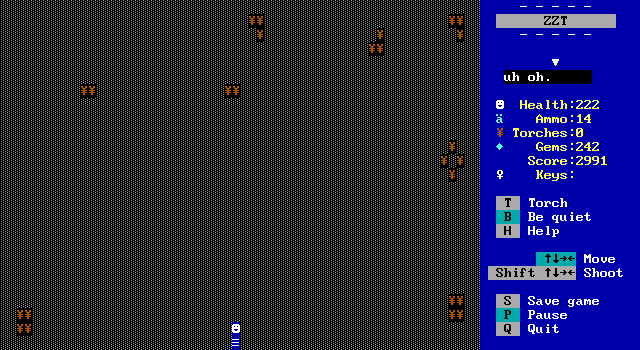
When I got there it finally dawned on me that getting more torches necessitated having torches to begin with. Janson's games tend to be tight on resources, but I didn't want to pull out cheats just yet, preferring to try and complete these worlds authentically.
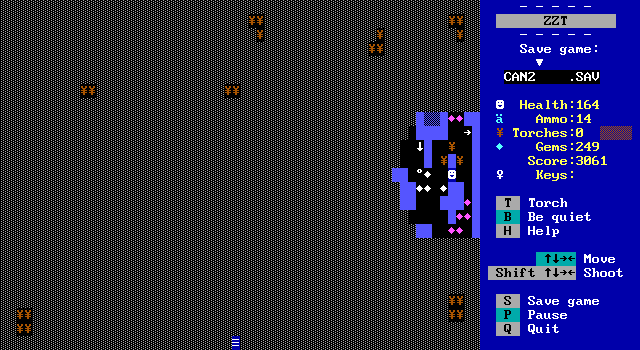
So I ran blindly in the darkness, getting mangled by spinning guns and probably a few bears in the process.
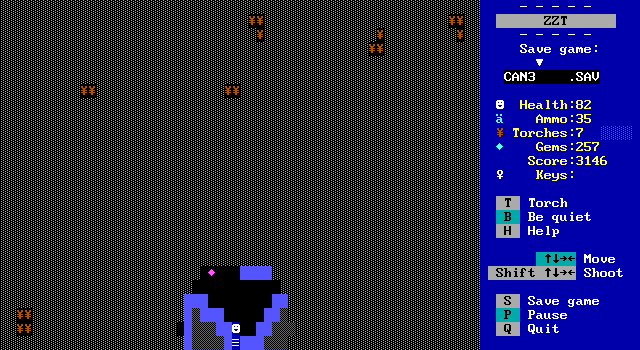
Once I had a torch, it was at least easy to get some more, but I still didn't feel like I needed to explore the entire cave. With all those spinning guns it felt like it would be too easy to end up losing more resources than I'd gain.
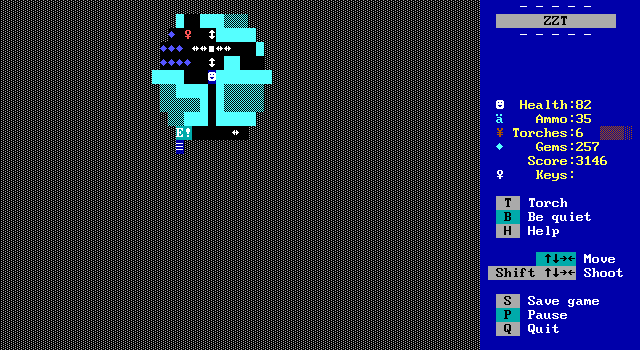

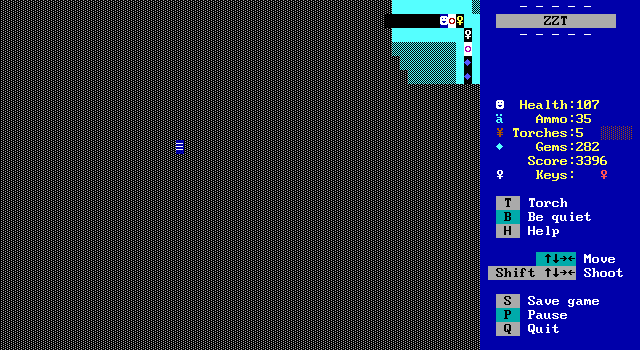
Returning to the Ice Cave with 7 total torches (good for a little under 2 and a half minutes of light) I was able to try a different path, picking up keys and opening some doors. Progress at least was being made, until I eventually hit a situation where I couldn't open any more doors.
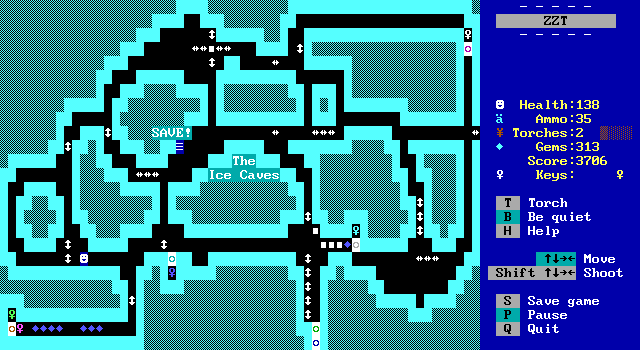
So I turned the lights on, revealing that once again I had softlocked myself in the exact same way. Worst of all, I had used the same save as the one I made after getting my supplies in the starting cave. I had to revert to an earlier one and trek into the cave for torches again.
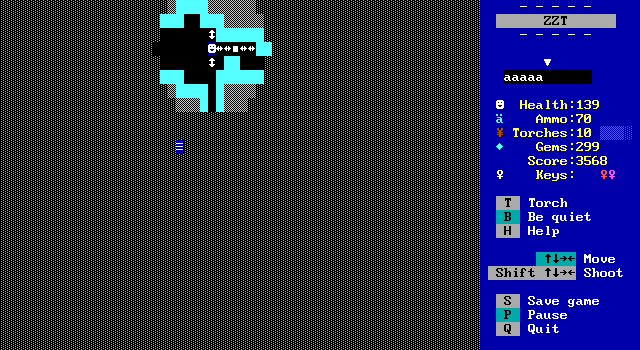
AND THEN I STILL MESSED IT UP. At least with a better save to restore from this time.
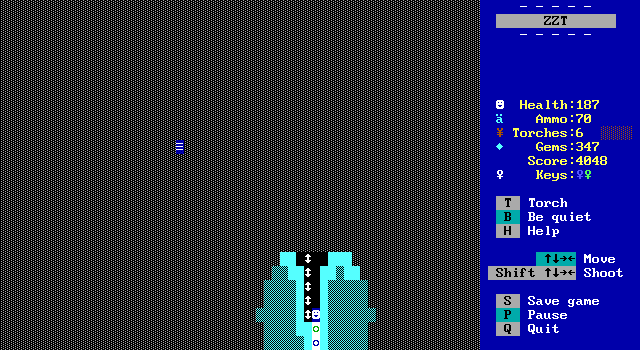
To Janson's credit, I'd say these failures are more on me than her. Had I paid attention to my torches and made a good safety save this would've gone a lot faster. Working with sliders frequently necessitates a spare save, and the Ice Cave is no exception.
This is also the sort of room that would go a little better if I was mapping it out on paper as well instead of trusting my abysmal memory to prevent me from pushing things that I should have known better than to push.
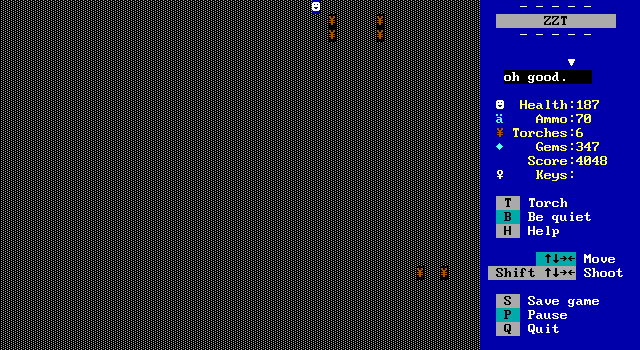
I was not particularly enthusiastic finding the next board to be another dark room. This one is still easy to softlock, but a lot more obvious about it.
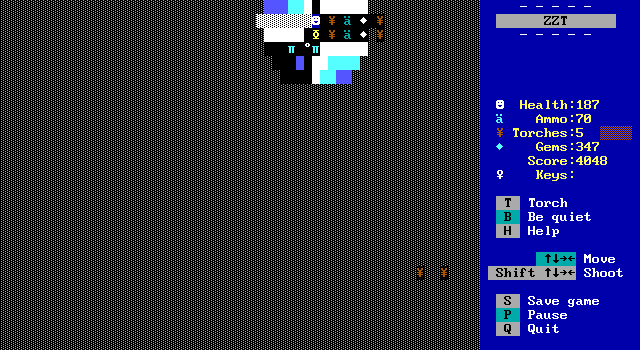
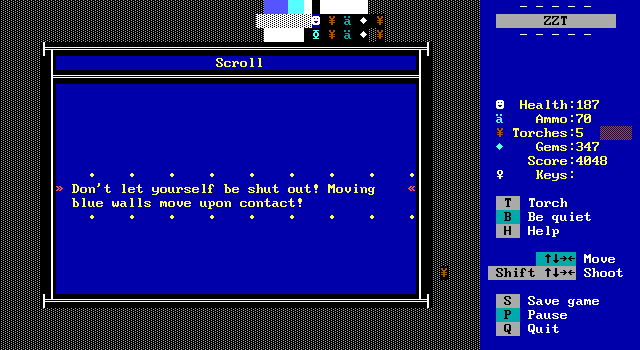
This time there are some bears and tigers for a more action-oriented board. A scroll warns about moving blue walls and some supplies saving me from another trip to the supply cave.
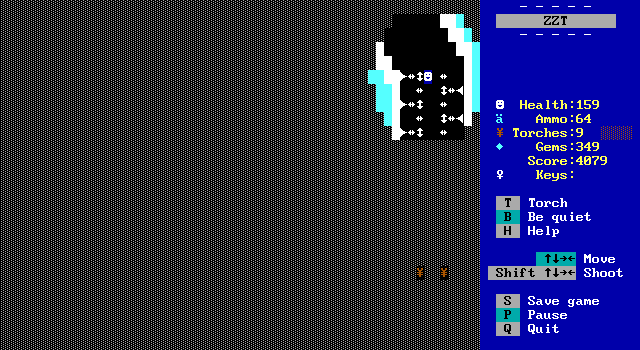
The path splits, and the right branch immediately looks pretty ominous. Something will no doubt make all these pushers start moving.
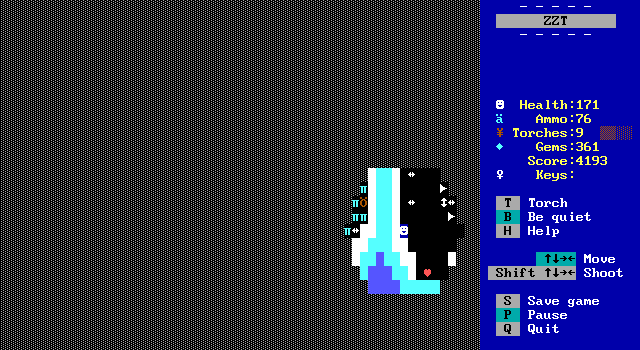
At the end are a bunch of (collected already) gems, and some more supplies, plus a heart item which will activate the trap and cause the player to become permanently stuck. I'm not a fan of this sort of design.
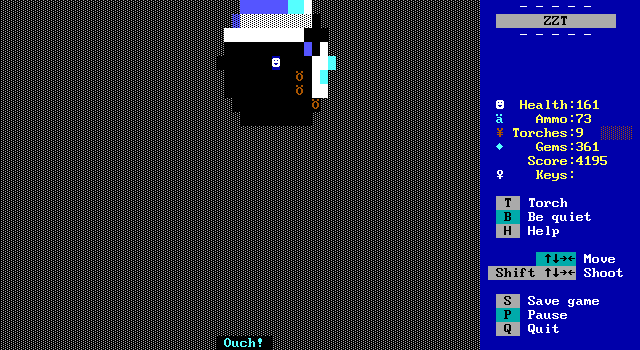
The main path involves passing the first of a few blue walls, which move once the player grazes against them. With the warning from the scroll it seems like I'd have softlocked already, but being trapped inside is fine. It's making a wall move without passing by it that's the actual danger.
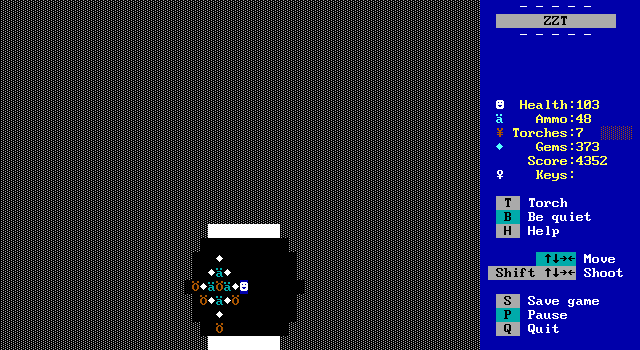
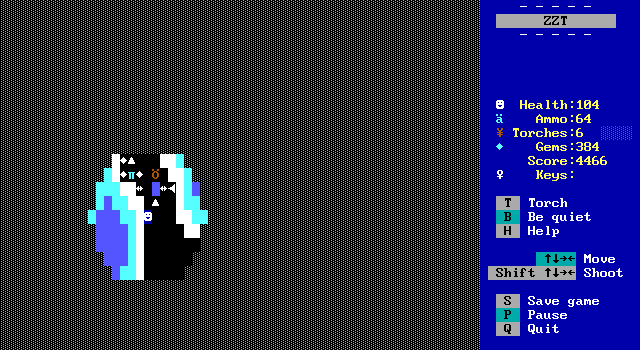
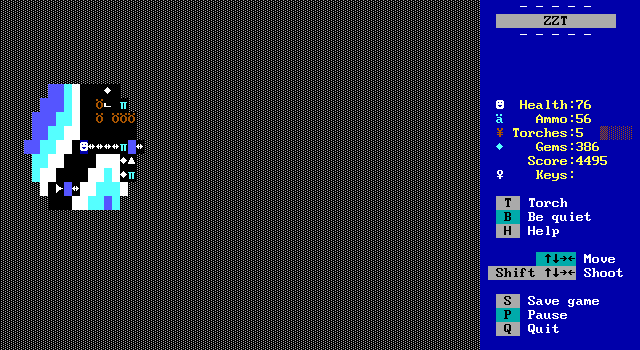
While the first part of the Ice Caves is a maze, this one is a refreshing linear path after that initial split.
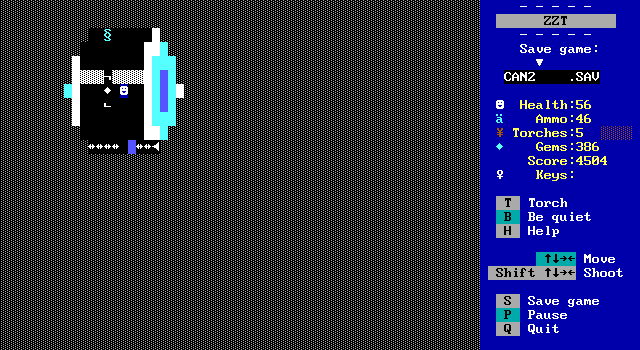
There's this cute little elevator the player gets to ride in in order to enter the Ice Dragon's lair and begin their fight for the statue.
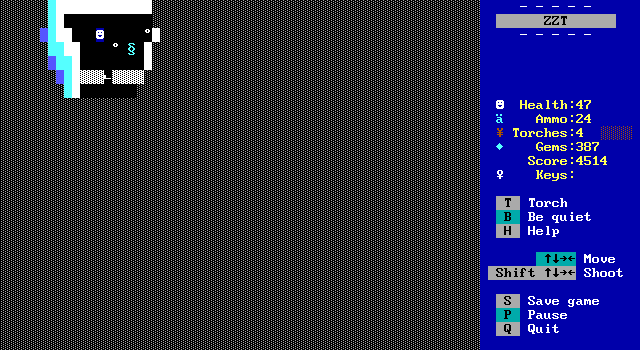
The Ice Dragon simply loops moving in a circle and firing in the same direction they move. This would be pretty easy normally, but the room is rather cramped so there's not a lot of room to dodge.
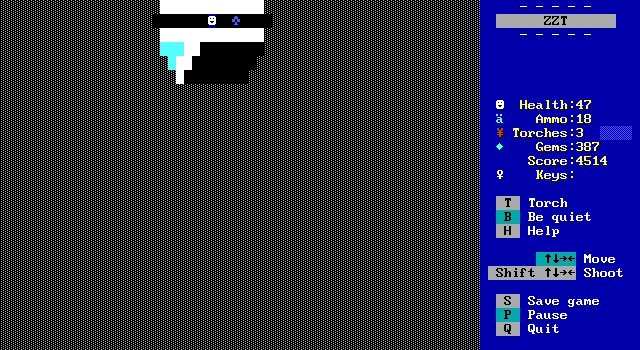
The dragon is easy enough that I didn't even make the connection that they were a boss until I picked up the statue and realized that I was done with this segment of the game.

Second quest completed, the statue is returned to its rightful place in the village and the gate to the back exit opens up.
Supplies are a little low, but I'm about two-thirds of the way to being able to open up the "WOW!" room.
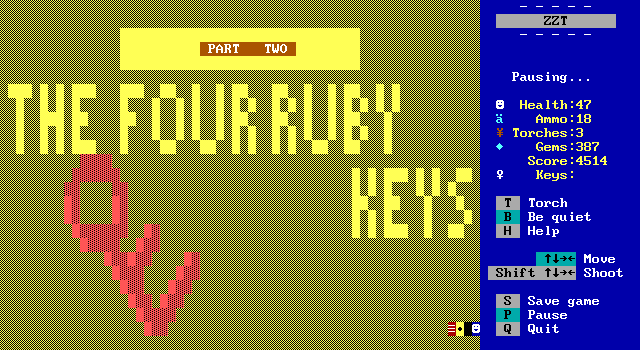
With their worth proven, the player now moves on to the next chapter, fulfilling the classic ZZT quest of collecting some keys.
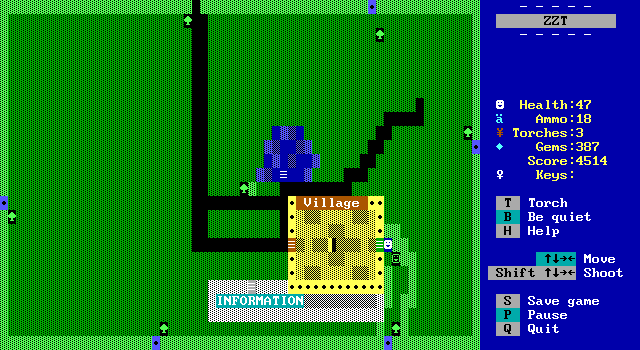
Unsurprisingly, this back exit leads back to the forest hub, but on the opposite end of the village of cannibals where there's somebody new to speak with.
I know you wish to escape from this
island. The other cannibals only wish you
for dinner.
There is one way off. Hidden beneath
the earth there is a secret ship. The
entrance is deep within a fortress. To
reach this ship, though, you will need
four ruby keys. The village kept one, and
hid the others in different places on the
island.
To go deeper into the forest, you
will require this key. It will open any
and all blue forest doors. Good Luck!
• • • • • • • • •
This is a nice little buildup Alexis has here. The game opens with these locked exits which appear to open one by one as the player completes quests, but here in part two, things really do become open. The key given by the cannibal lets the player travel along five previously locked paths in search of the ruby keys.
While the player can turn around, it's a pretty safe bet that they're going to head down this path they're already on first.

Things get classically ZZT here. The "Endless Forest" is not endless, or even a maze, but it is loaded with monsters. It follows the convention set in Town of having the background for a forest be made of torches to make things look brown, something pretty common until Alexis Janson released Super Tool Kit on the world.

Any confidence in my supplies vanishes pretty quickly. The first board was enough to wipe out almost all of my health and ammo. I decided to take a look at what was up ahead before turning back.

Yep. That's a pair of centipedes to free. Not going to happen without any ammo.
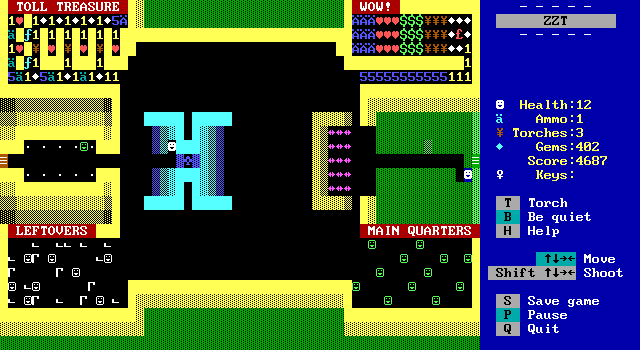
A cool touch Janson included were these extra passages that start out blocked but get revealed on the second pass through the area. The old passage that led to the "Part 2" board is erased, and the new passage leads directly to the back exit on the forest hub. I feel like a lot of ZZT games would just force the player to constantly go to the chapter introduction board every time they went through here, but Janson ensures that it's only seen the first time.
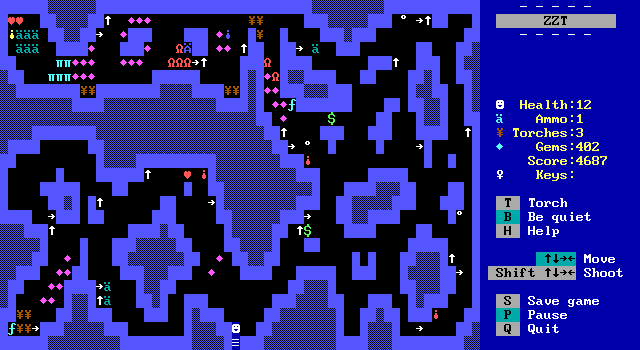
With a single bullet and 12 health, I decided to at least have a look at the entire supply cave if just to get an idea of what resources were even left. By this point, not a whole lot outside of the northwestern region which remained untouched.
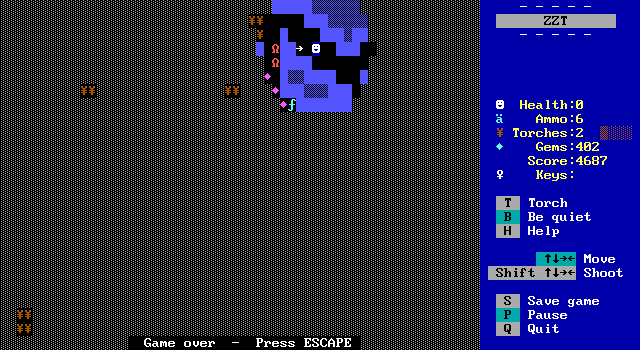
With my health being what it was however, getting past the guns was quickly turning into an exercise in frustration. They fire way too rapidly for the close distances they needed to be crossed from in order to do so safely.

Eventually one death in the same area was too many for me to tolerate. I brought myself back from the dead and proceeded without having to worry that a single step would bring my death.
Could I have played through this entire game without any cheats? Most likely. The early game's supply issues make it pretty challenging to get through, and I can recall running out of ammo in several of Janson's other games before. It's certainly not impossible, but it demanded a little more of me than I was willing to give.

Proceeding to the end there was one last potion, whose effects I couldn't recall, and sure enough it destroys every enemy. Including the otherwise indestructible spinning guns. Had I stumbled in this direction from the beginning I'd have probably come out ahead on health and not had to cheat. With over 400 gems collected at this point, that meant that I had lost well over 400 health, plus my original 100, and plus whatever health was given to me by potions and food found throughout the game. You take a lot of damage in this game, and large amounts are from these way too dangerous spinning guns.
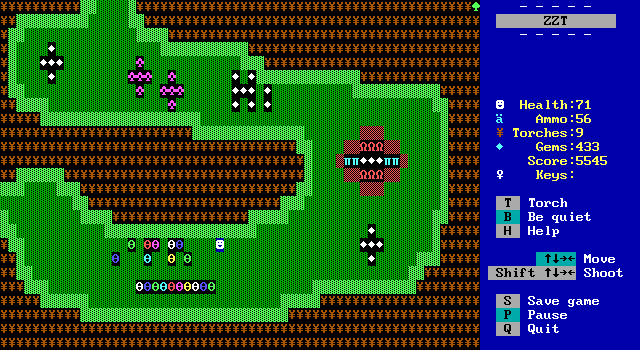
With some adequate health and ammo once more, I felt safe in making it past the centipede patch, which is where I learned of this board's gimmick: the forest regrows almost instantly. Any empty spaces are quickly turned into forest tiles which is an interesting dynamic that requires any shooting to be at nearly point blank range to be effective. Oh, wait a minute. That's why it's the "endless" forest, because it can't be destroyed.
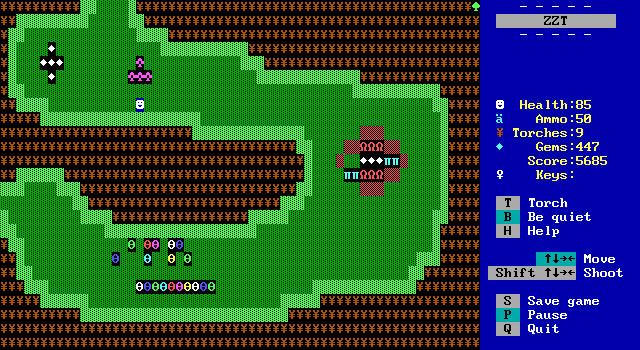
However, it also means that there's very little reason to do any shooting, and just hugging the edges to avoid having to free enemies.
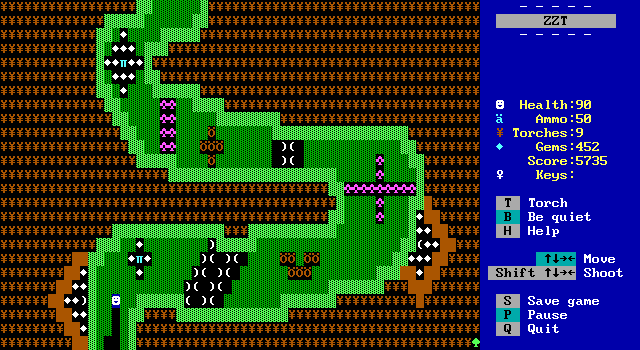
The next board still has an object in the corner, but this time the forest behaves normally. Probably to handle issues with transporters where the player will be blocked by forest and unable to use them if they don't have an empty space.
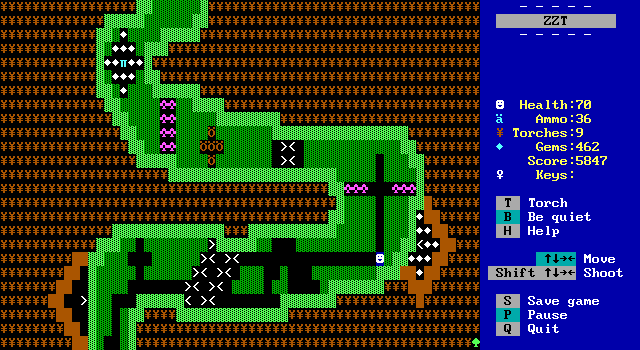
As always, the best tactic when dealing with enemies in forests is to create choke-points. The narrower the space for movement is, the easier it is to ensure any shots hit. Letting the ruffians here slowly funnel down the vertical shaft here makes it a lot easier to get past them than running towards them instead.

But I'm lazy and did it anyway.
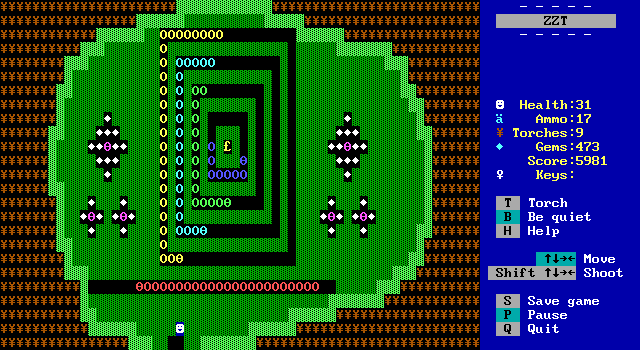
The endless forest ends with this fun room with rings of centipedes guarding the Gold Key. My ammo was too low to actually take them out, but their giant size meant it would be easy to avoid them.
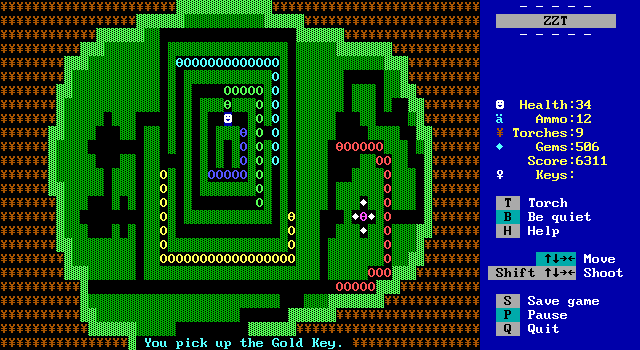
It got a bit dicey, but it's a lot of fun to try and get through without having to spend any ammo. The smaller pockets of gems with centipedes in the middle were too tempting to deprive myself of, with the 600 gem goal being ever closer because of them. Overall, it's a pretty solid board.
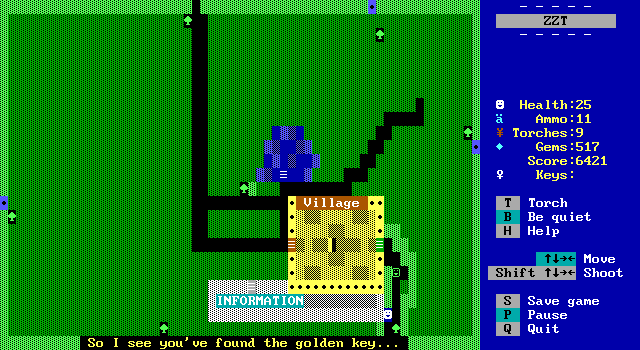
With the golden key collected, the cannibal out here runs off, taunting the player that they still need those Ruby Keys.

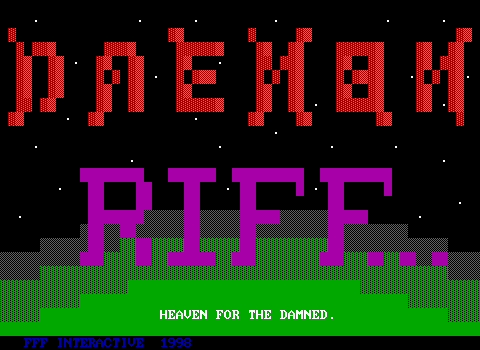

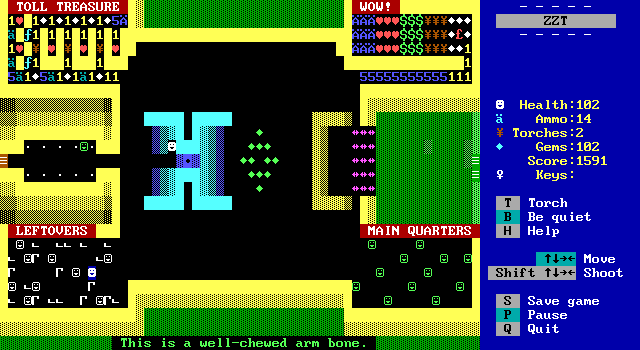

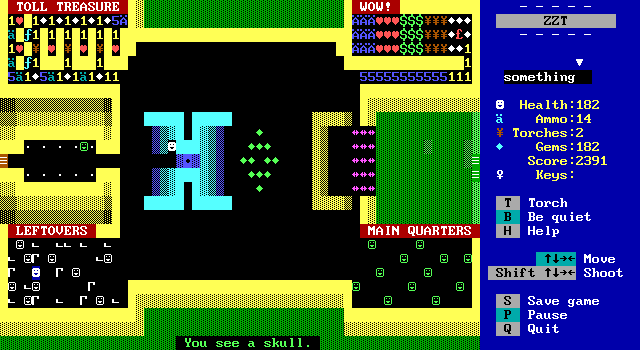
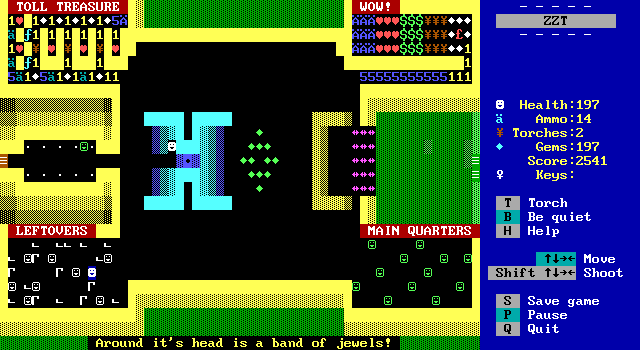
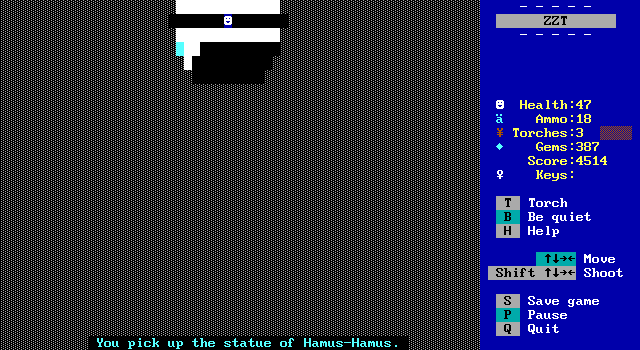
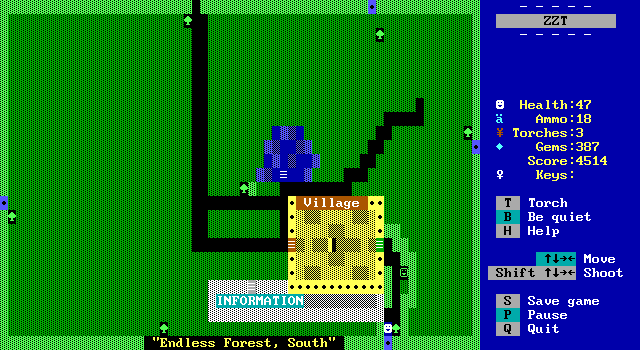
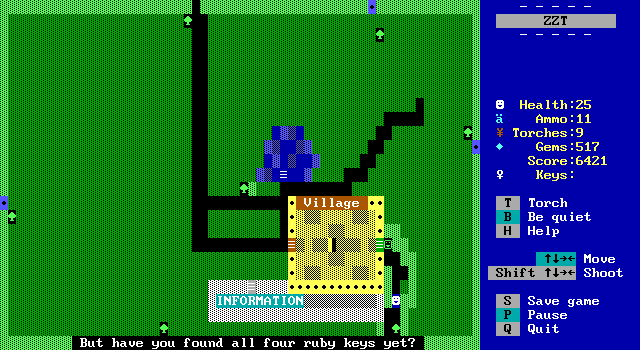
The title screen is colorful with the rainbow text constantly shifting colors. The scene itself is a distant shot of the island on a perfectly still ocean. This game being pre-STK, means the only dark blue available is using blue text and writing spaces. It's a simple title but it doesn't just settle for slapping the name of the game on it with nothing else.
Definitely the most notable part of the title is the accompanying music, an energetic theme that seems to be an original composition, for the first half at least, before it breaks down into drums and comes back as the theme from LucasArts's 1990 adventure game The Secret of Monkey Island!
Not only can you compare it with Monkey Island, but since LucasArts decided to support basically every method of playing sound via computer known to humanity of the time, you can compare it with the Monkey Island's own official PC speaker track as well!
Cannibal Island
Monkey Island - PC Speaker
Monkey Island - AdLib